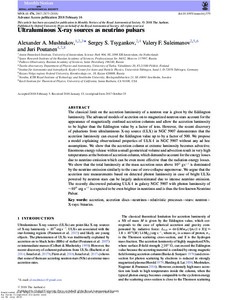Ultraluminous X-ray sources as neutrino pulsars
Alexander A Mushtukov; Juri Poutanen; Sergey S Tsygankov; Valery F Suleimanov
Ultraluminous X-ray sources as neutrino pulsars
Alexander A Mushtukov
Juri Poutanen
Sergey S Tsygankov
Valery F Suleimanov
OXFORD UNIV PRESS
Julkaisun pysyvä osoite on:
https://urn.fi/URN:NBN:fi-fe2021042719204
https://urn.fi/URN:NBN:fi-fe2021042719204
Tiivistelmä
The classical limit on the accretion luminosity of a neutron star is given by the Eddington luminosity. The advanced models of accretion on to magnetized neutron stars account for the appearance of magnetically confined accretion columns and allow the accretion luminosity to be higher than the Eddington value by a factor of tens. However, the recent discovery of pulsations from ultraluminous X-ray source (ULX) in NGC 5907 demonstrates that the accretion luminosity can exceed the Eddington value up to by a factor of 500. We propose a model explaining observational properties of ULX-1 in NGC 5907 without any ad hoc assumptions. We show that the accretion column at extreme luminosity becomes advective. Enormous energy release within a small geometrical volume and advection result in very high temperatures at the bottom of accretion column, which demand to account for the energy losses due to neutrino emission which can be even more effective than the radiation energy losses. We show that the total luminosity at the mass accretion rates above 1021 g s(-1) is dominated by the neutrino emission similarly to the case of core-collapse supernovae. We argue that the accretion rate measurements based on detected photon luminosity in case of bright ULXs powered by neutron stars can be largely underestimated due to intense neutrino emission. The recently discovered pulsating ULX-1 in galaxy NGC 5907 with photon luminosity of similar to 10(41) erg s(-1) is expected to be even brighter in neutrinos and is thus the first known Neutrino Pulsar.
Kokoelmat
- Rinnakkaistallenteet [19207]
